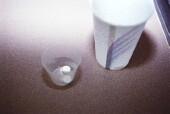
FRIDAY, Aug. 31 (HealthDay News) — Prepping for a “virtual colonoscopy” at the Mayo Clinic now only involves swallowing four cleansing tablets, rather than the large amounts of liquid laxative typically required, researchers report.
This summer, Mayo embraced the tablet bowel prep as its standard of care for patients undergoing noninvasive colonography, which relies on a CT scan to generate a 3-D snapshot of the patient’s colon and rectum.
The four-tablet prep, which contains the laxative agent bisacodyl, would not sufficiently prepare patients for a standard colonoscopy, which involves the insertion of a tiny camera into the patient’s large intestine for a real-time visual inspection of the region.
The screenings are recommended for people over 50 for early detection of colon cancer. The colonography route would suffice for the vast majority of patients, the Mayo team says, raising the prospect that an easier prep experience may encourage more people to undergo colon cancer screening.
“About 70 million Americans are eligible for a screening,” said Dr. C. Daniel Johnson, chair of the Mayo Clinic’s department of radiology in Arizona. “But today only about half actually do it. And one of the major obstacles has been the inconvenience of the bowel prep, which requires ingesting about a gallon of liquid the day before the procedure.”
When they compared the effect of a tablet prep vs. the full bowel prep in a group of colonography patients, “we really didn’t find any discernable difference between the two,” he added.
Johnson and his colleagues discussed their analysis of the tablet-prep option last year in the journal Abdominal Imaging.
Colonography is an extremely accurate means of picking up polyps that are either intermediate (6 to 9 millimeters) or large (1 centimeter or more), the researchers say.
However, Dr. David Greenwald, the gastrointestinal fellowship training director at Montefiore Medical Center at the Albert Einstein College of Medicine in New York City, pointed out that a virtual colonoscopy is not as good as colonoscopy at spotting smaller polyps, which may be precancerous or cancerous already.
Greenwald, a spokesman for the American Society for Gastrointestinal Endoscopy, also said that a colonoscopy has an advantage over a colonography in that any identified polyp can be removed right then without having to undergo a secondary procedure.
“But having said that, the first goal is to identify people with polyps,” he said. “So, any way we can help to get people into screening is welcome.”
Colon cancer is really a preventable disease, he added. “Many people believe that the standard prep for these screenings is the hardest part of the procedure and keeps screening rates down, so if bisacodyl tablets can get people into colonography screenings and help to find those polyps, that’s a good thing.”
Johnson acknowledged, however, that a colonography isn’t for everybody.
“About 2 to 5 percent of the population, those who have an inflammatory disease or an inherited disorder with multiple polyps forming at the colon, would be considered high-risk patients, and would need to undergo a colonoscopy,” he explained. “And for that the tablets would leave behind fecal debris in the colon that would interfere with the procedure. So they would need a full bowel prep.”
Mayo’s target population for the tablet prep? “The vast majority of patients over 50 who we would say are at average or intermediate risk for colorectal cancer would be eligible for CT colonography,” Johnson added.
“Of course, if we find a polyp during a colonography that patient has to then go on to have a colonoscopy,” he said. “But we only find a polyp that needs to be removed about 12 percent of the time. So that means that you have an 88 percent chance of not having to go on to a colonoscopy and undertake the more burdensome prep it involves. And we think those are pretty good odds.”
More information
For more on colorectal cancer, visit the U.S. National Institutes of Health.

